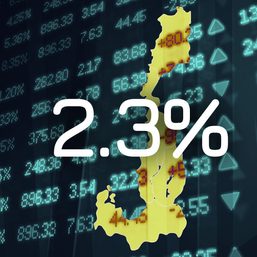SUMMARY
This is AI generated summarization, which may have errors. For context, always refer to the full article.
![[ANALYSIS] Should Filipinos worry about the bank failures abroad?](https://www.rappler.com/tachyon/2023/03/tl-bank-failure.jpg)
The last thing we want is to scare ourselves needlessly.
Earlier this month, California-based Silicon Valley Bank (SVB) experienced a classic “bank run”: depositors feared that SVB was in trouble, and they proceeded to withdraw their deposits in droves. The total amount of such withdrawals? A whopping $42 billion – or about a fourth of SVB’s total deposits – withdrawn in just one day.
SVB’s collapse would turn out to the second worst bank failure in US history, next to Washington Mutual back in 2008. It also happened very quickly, in a span of just two days.
On March 10, SVB was placed under the receivership of the Federal Deposit Insurance Corporation (FDIC), which declared that – rather unusually – all depositors of SVB will get their money back (and not just the deposits insured by FDIC).
Why did SVB collapse in the first place? Is there any risk of a contagion (i.e., more bank failures in the US and abroad)? What does this mean for Filipinos?
Background
Founded in 1983, SVB catered to the tech industry, with clients ranging from startups, venture capital firms, as well as more established companies in Silicon Valley.
Due to a string of initial public offerings (IPOs), and amid a surfeit of venture capital flowing across the global economy, SVB’s deposits more than tripled from 2020 to 2022. And as a typical bank, it sought to lend a huge part of that money to profit from interest.
However, the tech sector – SVB’s clientele – didn’t want to take out loans from SVB; in fact, they were the ones lending money to SVB through their deposits. So, SVB decided to put their windfall to work by investing in “risk-free” securities issued by the US federal government (essentially, they lent to the US government).
Typically, these long-term securities are deemed “risk-free” since whatever happens, you can be assured that you can get your money back. After all, the US government has the monopoly power to print dollars (in contrast to other securities where your money can disappear like a bubble).
So by end-2022, SVB held a whopping $117 billion in long-term government securities (which matured in 10 years) as well as mortgage-backed securities (which figured prominently in the 2008-2009 US financial crisis).
Bank run
The problem is that the US Federal Reserve (their central bank) raised interest rates throughout 2022, owing to the historic rise of inflation in the US.
You see, whenever inflation rises significantly, the Federal Reserve steps in to raise interest rates and dissuade people from spending on items like new housing or new vehicles. This, in turn, dampens demand and inflation.
But this presents a problem for everyone holding interest-bearing assets, whose prices plummet every time interest rates rise.
The reason is as follows: as interest rates rise, people who buy securities now can expect to earn higher interest in the future. But if you bought your securities before the interest rate hike, your securities fetch a lower price and are not as attractive as newer securities. Therefore, the value of old securities drops.
Since SVB held so much of these long-term bonds, the price of those bonds plummeted as interest rates rose, resulting in humongous losses. In fact, days before its collapse, SVB was notified by Moody’s, a credit rating agency, of a possible credit rating downgrade – precisely because of the risk posed by all those long-term bonds.
On March 8, SVB announced it would sell $21 billion of those bonds. Then they also announced plans to raise an extra $2.25 billion from the issuance of new shares in SVB.
This served as a major red flag among depositors.
By March 9, Founders Fund, a venture capital firm that banked with SVB, advised other companies to pull their funds from SVB. As word of this spread, SVB’s depositors panicked, culminating in a bank run. On March 9 alone, SVB’s share price plunged by 60%. On March 10, the share price dropped by another 47%, and trading of its shares was halted on the same day.
Unsurprisingly, a bank collapse as large as this set off ripples of panic in the rest of the financial world.
New York-based Signature Bank collapsed on March 13, as their own depositors withdrew $10 billion – the third largest bank collapse in US history. Then On March 16, Credit Suisse, a global bank, said it would borrow $53.7 billion from the Swiss central bank to shore up its liquidity. On the same day, San Francisco-based First Republic Bank took in $30 billion worth of deposits from 11 large US banks, so it could avoid collapse.
Despite these movements, US Treasury Secretary Janet Yellen gave assurances that the American banking system was still “sound.”
Will it affect the Philippines?
Apart from moderate stock market jitters, we have so far avoided the worst effects of SVB’s collapse.
Also, President Marcos Jr.’s technocrats assured the public that there will be no fallout in the country from SVB’s collapse.
Finance Secretary Benjamin Diokno said, “The Philippine banking system is sound and well-capitalized. There is no reported exposure of Philippine banks to Silicon Valley Bank.” (Funnily, this isn’t the first time Diokno commented on issues that are in the purview of the Bangko Sentral ng Pilipinas; Diokno was the previous BSP governor.)
For his part, BSP Governor Felipe Medalla said, “The Philippine banking system has no reported exposures to the Silicon Valley Bank (SVB). The PBS continues to exhibit safety, soundness, and resilience amid the collapse of SVB and two other banks in the US.”
The Bankers Association of the Philippines (BAP) made a similar assessment, adding that, “[B]anks in the Philippines continue to have capital and liquidity ratios that exceed the requirements set by the BSP.”
Yet we shouldn’t be so complacent.
First, we have to wait and see if the contagion of fear has stopped spreading or not. In the past, financial crises were brought about by “self-fulfilling prophecies.” Fear begets fear, and this is why it’s crucial for authorities in the US and elsewhere to step in early enough to calm down markets and fear from spreading. Banks on the brink of failure may also need to be rescued one way or another. Already, as of March 19, Switzerland’s largest bank UBS moved to acquire Credit Suisse for $3.2 billion. In the US, another bank is trying to acquire Signature Bank.
Second, it will be interesting to see if the US Federal Reserve will stop raising interest rates following SVB’s collapse.
For months, critics have said that continuously raising interest rates is a clumsy, if not damaging, response to inflation, and it ought to stop. The collapse of SVB – driven largely by the loss of value of its securities following successive interest rate hikes – should give the US Federal Reserve some pause. (Maybe the BSP ought to do the same?)
Third and last, we should be wary of policies coming from the Marcos government that can compromise the financial health of our banks.
For instance, Marcos’ proposed Maharlika Investment Fund will supposedly draw P50 billion from the Land Bank of the Philippines, and another P25 billion from the Development Bank of the Philippines. Yet some analysts have shown that in doing so, these state banks will not be able to meet their capital adequacy and leverage ratios – measures of banks’ soundness and strength.
If these banks get into much trouble, that could set off real problems in our own shores. Unfortunately, Maharlika is still being endorsed by Marcos’s own cadre of technocrats. What gives? – Rappler.com
JC Punongbayan, PhD is an assistant professor at the UP School of Economics and the author of False Nostalgia: The Marcos “Golden Age” Myths and How to Debunk Them. JC’s views are independent of his affiliations. Follow him on Twitter (@jcpunongbayan) and Usapang Econ Podcast.
Add a comment
How does this make you feel?
![[In This Economy] Runaway rice prices are making inflation higher than it needs to be](https://www.rappler.com/tachyon/2024/02/tl-rice-prices.jpg?resize=257%2C257&crop=560px%2C0px%2C720px%2C720px)
![[ANALYSIS] A soft and range-bound stock market that has not lost its luster](https://www.rappler.com/tachyon/2024/02/TL-market-soft-range-bound-February-9-2024.jpg?resize=257%2C257&crop_strategy=attention)
![[In This Economy] Looks like PH economy will never get back on track. Here’s the data.](https://www.rappler.com/tachyon/2024/02/20240202-PH-economy-back-on-track.jpg?resize=257%2C257&crop=289px%2C0px%2C720px%2C720px)




There are no comments yet. Add your comment to start the conversation.